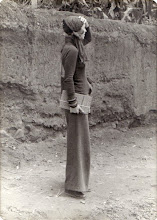 When thinking of political art, Mexican Muralism and Soviet Social Realism may pop immediately to mind. Modernist art and its offshoots have always been influenced by politics, agreeing and disagreeing, even if it's as subtle as Abstract Expressionism's parallels of isolationist Cold War sentiments. Until now, art history has been socially and politically contextualized as a reaction and representation of global forces peaking and falling.
When thinking of political art, Mexican Muralism and Soviet Social Realism may pop immediately to mind. Modernist art and its offshoots have always been influenced by politics, agreeing and disagreeing, even if it's as subtle as Abstract Expressionism's parallels of isolationist Cold War sentiments. Until now, art history has been socially and politically contextualized as a reaction and representation of global forces peaking and falling.Diego Rivera
ManifestHopeDC seems to have shown otherwise. Artists both routinely and sporadically supported by the institutional mechanisms of the art world took it upon themselves to spread an earnest political message, and in my opinion, if their current recognition means anything, art effectively influenced politics and the way the public conceives of its political figures. As Foucault mentions, "objects and concepts are created by our discourses about them, " and in seeing the grassroots, artistic production, as well as the widespread association by individuals of the president with the personal chord that Fairey's poster strikes in each of them, perhaps we can also say that art has granted a good deal of Foucault's non-pre-existing knowledge to both political and personal terms, to the concept of presidency, leadership and and representation.If art has indeed replaced religion, as Donald Kuspit quotes Donald Bell as saying, then the Hope poster is our stained-glass window, in every parish, low and high brow (streets to national galleries), its role recognized outside the narrow scope of the monastic art world and by the secular leaders as a force to be reckoned with and respected. Truth and integrity seem to shine through the brilliant panels as the spectator approaches in awe. Upon entering the threshold of our neutral-not-so-neutral exhibition space, the light is charged with meaning, one that is not the self-reification of an institution trying to guarantee the reproduction of its own definitional power, but a populist light that belongs to no one - we belong to it. It has appropriated us, our media and our institutions. It has become a part of our collective subconscious, a concept so beyond the perils of ownership and copyright so as to enter our reflexes and desires.
Hybrid culture is remixing us.
ManifestHopeDC seems to have shown otherwise. Artists both routinely and sporadically supported by the institutional mechanisms of the art world took it upon themselves to spread an earnest political message, and in my opinion, if their current recognition means anything, art effectively influenced politics and the way the public conceives of its political figures. As Foucault mentions, "objects and concepts are created by our discourses about them, " and in seeing the grassroots, artistic production, as well as the widespread association by individuals of the president with the personal chord that Fairey's poster strikes in each of them, perhaps we can also say that art has granted a good deal of Foucault's non-pre-existing knowledge to both political and personal terms, to the concept of presidency, leadership and and representation.If art has indeed replaced religion, as Donald Kuspit quotes Donald Bell as saying, then the Hope poster is our stained-glass window, in every parish, low and high brow (streets to national galleries), its role recognized outside the narrow scope of the monastic art world and by the secular leaders as a force to be reckoned with and respected. Truth and integrity seem to shine through the brilliant panels as the spectator approaches in awe. Upon entering the threshold of our neutral-not-so-neutral exhibition space, the light is charged with meaning, one that is not the self-reification of an institution trying to guarantee the reproduction of its own definitional power, but a populist light that belongs to no one - we belong to it. It has appropriated us, our media and our institutions. It has become a part of our collective subconscious, a concept so beyond the perils of ownership and copyright so as to enter our reflexes and desires.
Hybrid culture is remixing us.
Meeting of a Village Party Cell, Efim Cheptsov


Aucun commentaire:
Enregistrer un commentaire